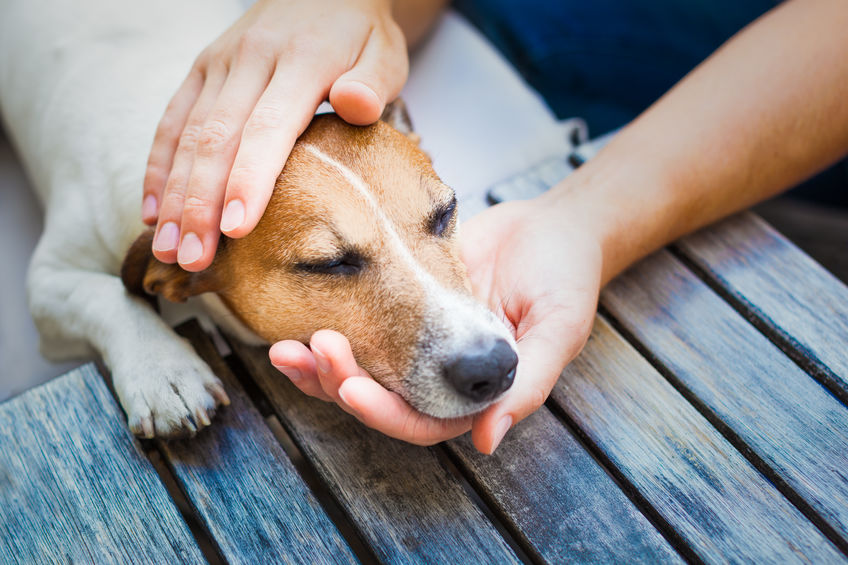A dog breathing fast may be a cause for concern for pet owners. This is especially the case for people with older dogs. Sometimes, this is normal — some adult dogs, and even puppies, just breathe fast. But other times it’s not normal. It’s important to know the difference, because knowing what’s normal and what’s not normal can have a big impact on your dog’s health.
How can you tell? If your pet experiences rapid breathing on a regular basis, get to a veterinarian. This is especially true if your pet is having difficulty breathing.
Now, let’s take a look at how the canine respiratory system is supposed to work, and some of the reasons why rapid breathing happens.
Breathing in Dogs – How it’s Supposed to Work
If breathing in dogs becomes labored, there’s a chance that something might be wrong with their respiratory system. There are a lot of parts comprising this system. That means there are a lot of different problems that may occur.
The canine respiratory system includes your dog’s mouth, nose, lungs, throat, and windpipe, or trachea. Air comes through the mouth and nose and into the lungs, where red blood cells absorb oxygen. Then, red blood cells then transport oxygen throughout your dog’s body.
At the same time, those red blood cells transfer carbon dioxide to the air inside the lungs. The carbon dioxide then goes out through the dog’s mouth and nose.1
What is the Normal Respiratory Rate for Dogs?
There is no one-size-fits-all answer to this question. Generally, dogs should typically have a resting respiratory rate of anywhere from 15 to 30 breaths per minute, but some dogs have a normal respiratory rate that’s slower or faster.
As long as your pet is acting normal, a respiratory rate outside a bit of this range should be okay. For example, lots of dogs pant, and it doesn’t necessarily mean something is wrong.
But if your pet breathes at a rate of more than 30 breaths per minute, that is not generally considered normal. If you have any concerns, your vet can tell you what the normal breathing rate is for your dog.2
Is Your Dog Having Difficulty Breathing?
When a dog has difficulty breathing, that’s known as dyspnea. Rapid breathing is also known as tachypnea. Here’s a look at each condition:
-
Dyspnea
Excessive or rapid panting can be one of the signs of dyspnea. It can occur when the dog is taking air into the nasal cavities and mouth too quickly, or when air is going out of the nose and mouth too fast.
Dyspnea typically includes noisy breathing and breathing with the mouth open. Your pet might or might not be panting at the same time.
Other symptoms include holding the neck and head low, and a refusal to lie down. Some dogs with labored breathing are uncomfortable while lying down.3
Another one of the more common symptoms of dyspnea is breathing from the stomach — so check to see if your pet’s stomach is moving in conjunction with their chest Also, check your pup’s gums: blue gums are another potential sign of dyspnea.4
Causes of Dyspnea
There are a lot of potential causes of dyspnea, including structural issues with the airway and illness. Here are some of the more common ones:
Tracheal Collapse
 Tracheal collapse is something that occurs over time. Unfortunately, it can’t be reversed. When the cartilage that comprises the trachea weakens, it becomes flat. Eventually, the collapse makes it hard to breathe through the upper airway. Smaller dogs are usually at a higher risk, like Poodles, Pomeranians, and Chihuahuas.
Tracheal collapse is something that occurs over time. Unfortunately, it can’t be reversed. When the cartilage that comprises the trachea weakens, it becomes flat. Eventually, the collapse makes it hard to breathe through the upper airway. Smaller dogs are usually at a higher risk, like Poodles, Pomeranians, and Chihuahuas.
While this condition involving the trachea can’t be cured, it can be managed. Treatment will sometimes include medications to reduce spasms in the airway that can lead to pain.
In some instances, however, surgery may be needed.5
Laryngeal Paralysis
The larynx is designed to open after inhaling, and close after exhaling. It’s also supposed to close when eating or drinking. However, when laryngeal paralysis occurs, the larynx can’t operate correctly. Signs of this may include excessive panting and noisy breathing.
Older dogs are more susceptible to this condition. Certain breeds are at a higher risk as well. These include Golden Retrievers, Labrador Retrievers, and different types of Setters.
It’s not known what causes laryngeal paralysis — but it is believed to be one of the contributing factors is damaged nerves in the larynx muscles.
Treatment may include oxygen or surgery. Thankfully, there is a very good chance they will live a long, happy life. Your vet may also recommend medication for pain.6
Pneumonia
Pneumonia is as dangerous to your pet as it is to you. It happens when an infection strikes the lungs, which allows fluid to build up in the airway and the chest cavity. This fluid, in turn, leads to breathing difficulty. Signs could include fever, noisy breathing, blue gums, weakness, and loss of appetite.
There are a lot of reasons why a dog may develop fluid accumulation that can lead to pneumonia. Gastrointestinal disease may be a factor, as well as recent anesthesia or vomiting.
As dangerous as pneumonia can be, your vet can determine the cause of the fluid buildup and come up with a treatment. Blood tests and x-rays will likely be performed, and your vet may prescribe certain medications to help.7
-
Tachypnea
Tachypnea, or rapid breathing, is another potentially serious problem that can affect breathing in dogs.8
 Symptoms include a faster than normal breathing rate and shallow breathing.
Symptoms include a faster than normal breathing rate and shallow breathing.
Causes of Tachypnea
There are many potential reasons a dog could develop tachypnea, or fast breathing. Here are just a few of them:
Mitral Valve Disease
This is a gradual thickening of the mitral valve which separates the left atrium of the heart from the left ventricle. It can sometimes be a sign of heart failure. However, many dogs with mitral valve disease never suffer from heart failure – even if they’ve been diagnosed with a murmur.
One of the more common symptoms of this disease is excessive panting and an increased rate of breathing after minimal exercise. Coughing after exercising is also common. Some dogs with the disease find it hard to get comfortable. Some also experience a loss of appetite. If you notice any of these signs, call your vet immediately.9
Lung Disease
Lung disease can result from a viral or bacterial infection, parasites, or one of many other causes. When the blood cells in the lungs can’t carry oxygen as they should, breathing may become more rapid as a result.10
Heat Exhaustion
Heat exhaustion occurs when a dog’s internal temperature gets too high. Signs include rapid breathing, excessive panting, excessive drooling, reddened gums, vomiting, and dehydration.
Heat exhaustion can lead to heatstroke if the symptoms are not immediately addressed. If your pet is showing signs of heat exhaustion, you will need to get them inside as soon as possible. If you can’t do that, get your pet to shade or take them to the vet.11

Why do Brachycephalic Breeds Have Difficulty Breathing?
Certain breeds of dogs are known as brachycephalic breeds. They tend to have short heads and flat faces. These include Boxers, Boston Terriers, Bulldogs, Pugs, and Shar-Peis.12 While they are cute, they are also susceptible to breathing difficulties.
One of the more common problems affecting this type of dog is known as brachycephalic syndrome. This condition occurs because of an obstructed airway. These breeds have an abnormally shaped soft palate which can partially block their airway. If this tissue gets inflamed due to stress or heat, that can completely block the airway.13
Issues Brachycephalic Breeds Face
Any pet who is a member of a brachycephalic breed will have some degree of brachycephalic syndrome. Here are some of the more common problems in dogs with this condition.
Collapsed nostrils – Also known as stenotic nares, this can make it hard for a pet to breathe through their nose. It can result in difficulty breathing, and it can also make it hard for a pet to exercise.
Everted laryngeal saccules – When a pet has trouble breathing, this can cause pouches, called saccules, in the larynx to turn inside out, or “evert.” If they become everted, that can lead to airway obstruction.
Heatstroke – Brachycephalic breeds are also at a higher risk of heatstroke because they have trouble panting enough in order to get enough air, and their bodies can’t cool down as a result.
Tracheal stenosis – This is a narrowing of the trachea, also known as the windpipe, and it can make panting very hard.14
Caring for Brachycephalic Breeds
If you plan to get one of these breeds, don’t worry — there are ways to help them live a long, happy life. It’s important to realize, however, that bringing a brachycephalic breed into your home will carry some special responsibilities.
For example, you’ll need to keep a close eye on your pet’s weight. If your dog is putting on some pounds, you should put your pet on a weight loss program. Check your dog food to make sure it contains healthy ingredients that won’t put your pup at risk for obesity.
 Also, be careful when exercising your pet. Don’t go out for walks when it’s hot or humid, and keep your dog inside during the summer to help them avoid becoming overheated. Keep stress to a minimum.15
Also, be careful when exercising your pet. Don’t go out for walks when it’s hot or humid, and keep your dog inside during the summer to help them avoid becoming overheated. Keep stress to a minimum.15
When Should I Consult a Vet for Rapid Breathing?
No matter what type of breed your pet may be, you should always be on the lookout for symptoms of breathing problems. If you notice any breathing issues out of the norm, don’t be afraid to take action.
Stay Observant
If you have a dog prone to difficulty breathing, keep an eye on your pet. Pay attention to the number of breaths per minute, and look for any signs of a serious problem — such as pain, a loss of appetite, or other symptoms.
When breathing in dogs becomes difficult, that can lead to a lot of stress — for you AND your pet! Owners will feel stressed for their pets. But, if you’re paying close attention, there’s a good chance your canine companion will be fine in the long run. Just stay alert, and stay vigilant.
Learn More:
Are Bananas Good for Dogs? (can dogs eat bananas?)
What is Cat Bunting?
Is a High Energy Dog Breed Right for You?
Sources
- https://www.petmd.com/dog/conditions/respiratory/c_dg_dyspnea_tachypnea_panting
- https://vcahospitals.com/know-your-pet/home-breathing-rate-evaluation
- https://vetmed.tufts.edu/heartsmart/symptoms/difficulty-breathing/
- https://wagwalking.com/symptom/why-is-my-dog-breathing-from-the-stomach
- https://www.acvs.org/small-animal/tracheal-collapse
- http://www.pethealthnetwork.com/dog-health/dog-diseases-conditions-a-z/laryngeal-paralysis-not-a-death-sentence
- http://www.pethealthnetwork.com/dog-health/dog-diseases-conditions-a-z/aspiration-pneumonia-dogs
- https://www.petplace.com/article/dogs/pet-health/tachypnea-fast-breathing-in-dogs/
- https://www.vetmed.wsu.edu/outreach/Pet-Health-Topics/categories/diseases/heart-valve-malfunction-in-the-dog
- https://www.merckvetmanual.com/dog-owners/lung-and-airway-disorders-of-dogs/introduction-to-lung-and-airway-disorders-of-dogs
- https://wagwalking.com/wellness/can-dogs-get-heat-exhaustion
- https://www.mspca.org/angell_services/caring-for-brachycephalic-dogs/
- http://www.vetstreet.com/care/my-pet-is-breathing-weird-what-should-i-do
- https://www.petcarerx.com/article/brachycephalic-dog-breeds/1337
- https://vcahospitals.com/know-your-pet/brachycephalic-airway-syndrome-in-dogs




























